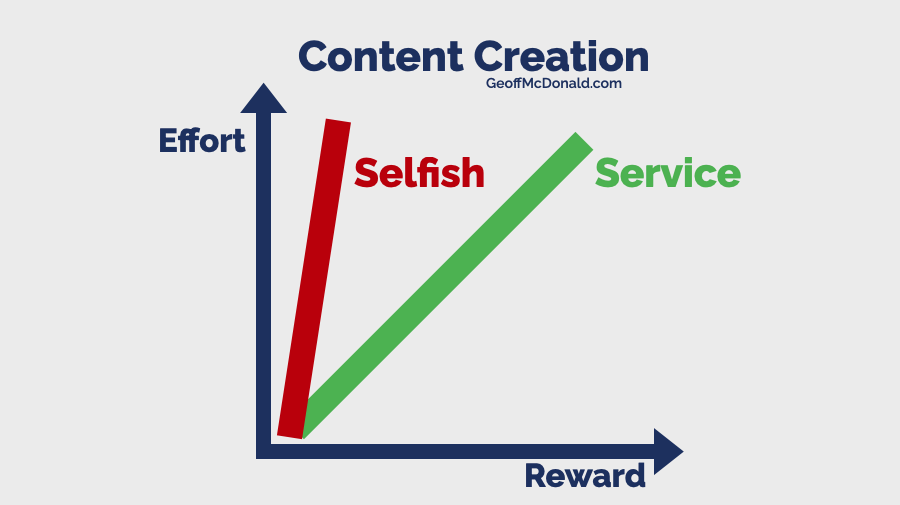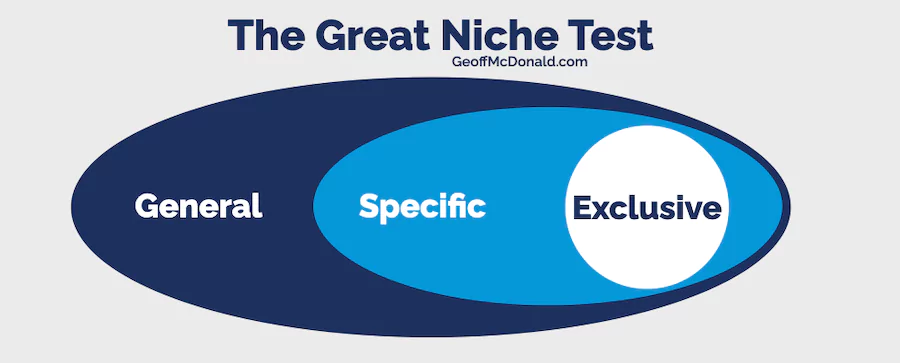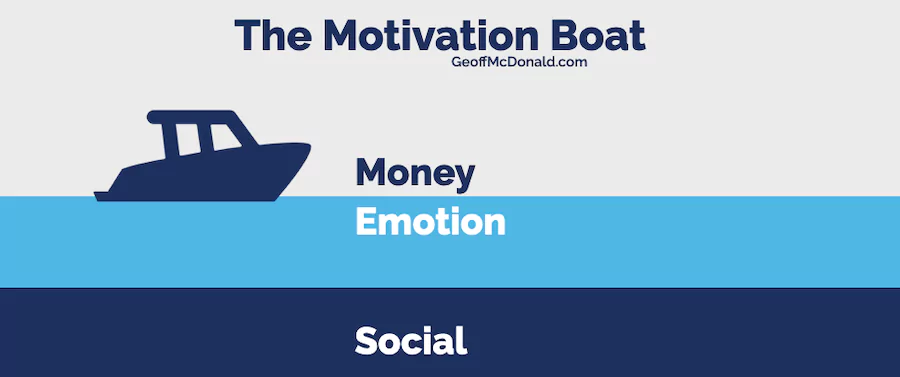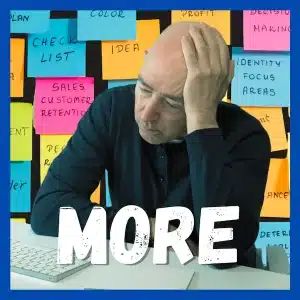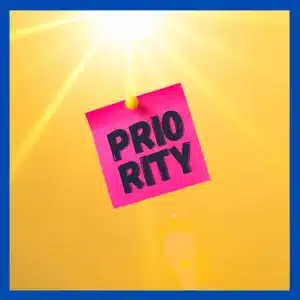To attract your ideal clients you’ll need a content creation value proposition.
Content marketing is a modern miracle – you create content, you publish it online and clients turn up in your inbox. That’s amazing, right?
Every time it happens to me, I get really excited and I’m proud of my efforts. I’m really pleased that I spent all that time creating content that made a difference to someone.
But for a lot of content creators, this never happens. They spend a lot of time creating, but no clients turn up. That’s a lot of effort for a low reward.
But we all want a fair reward for our effort. We want to have that feeling of doing a good job that made a difference.
The Real Challenge of Content Marketing
One of the challenges of content creation and content marketing is that there is so much competition and noise in the marketplace. While we all want to stand out, so do the millions of other people who are chasing the same dream of being seen and heard.
But we can’t do much about the level of competition we face. Some things are just outside of our control.
The bigger problem for many content creators is self-inflicted – You’re doing this to yourself.
The big reason that you don’t attract new clients is that you’re being selfish, and you don’t even know it.
If you’re not getting the results you want from your content creation, then today’s post might just show you how to fix this.
The Two Levels of Selfish Content
There are two levels of selfish content
1 Blatant Selfishness

I see this on LinkedIn all the time – it’s people pushing their podcast – either their own show or them being interviewed on someone else’s show. The usual post goes something like this… I had a fantastic chat with the amazing Mr X and you should listen to us solving the whole world’s problem.
That doesn’t appeal to me at all.
The problem is they don’t tell you why you should listen to them.
But wait, it gets worse…
Its people quoting themselves with a big picture of – you guessed it – them smiling at you.
- Is it arrogance?
- Is it narcissism?
- Or just plain selfish?
Either way, that’s not going to attract a lot of new clients.
2 The Experts Curse
The second level of selfish content is the Experts Curse. It’s when you know your content and your IP so well that you forget that other people don’t.
I worked with a guy a few years ago, who was an expert in organizational strategy. He’s a very clever guy who works really hard and is very good at what he does. He deserves success. But he’s not so good at selling himself. He knows that his potential clients need a strategy update. But the problem is, his clients don’t know this.
His clients are running around saying:
- Oh, we need to capture more market share
- Ah, we need to minimise our cost base
- Yes, we need to launch a new product offer.
Can you see the gap here?
The clients are talking about their problem, he’s talking about his solution and there is no bridge or translation between the two.
The Number One Reason Your Content is Not Attracting New Clients
Je suis désolé je ne parle qu’un peu le français.
Did you get that?
That’s what it’s like for our potential clients when we speak in our language and not theirs.
(In case you didn’t understand, I said: I am sorry, I only speak a little French.)
The number one reason you are not attracting new clients with your content creation is that you’re speaking a foreign language. You’re being selfish and you don’t even know it.
The Content Creation Canvas Series
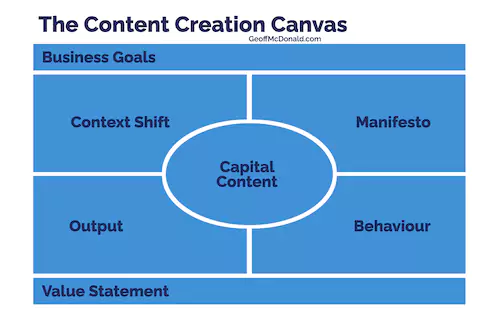
Previously in Part One, we talked about the three essential goals for creating thought leadership quality content and the one master goal or hyperfocus.
That was all about you and what you want.
In this post, we’re flipping the conversation. Today, we’re talking about your clients and what they want.
And if you’re not getting the results from your content creation then this might just be the answer you’re looking for.
What is a Value Proposition?
A Value Proposition or Client Value Statement is a description of your ideal client or end-user. It also includes the things they want to have and avoid, plus their motivations for wanting this.
In this post, we are using the three-part Product Story Formula from the software development process of Scrum and Agile.
Previously, we talked about this in this post: Know Your Clients Thoughts.
In this post, I’ll run through how to create your own Value Proposition or Client Value Statement using my personal example.
If you want a more detailed process, then I highly recommend the Strategyzer Value Proposition Canvas and the Value Proposition book that goes with their canvas. (I rapped this over at Book Rapper)
My tip is to run through this simple process first, then if you need more you can follow up on this resource.
The Scrum Product Story Formula
Traditionally when we create a project we create a list of tasks – a to-do list.
But when you’re wanting to create innovative and meaningful client solutions, this can trap you into thinking in traditional and conventional ways.
Human beings think in terms of stories and narratives. This is how we create meaning in the world. The key here is that we need to interpret the story, and this is the secret to innovative solutions.
It also helps to keep our story simple and small so we can focus on a single clear objective.
We’re using the three-question Scrum Product Story formula as a simple tool to define our client value statement or value proposition.
1 Who is Your Client?
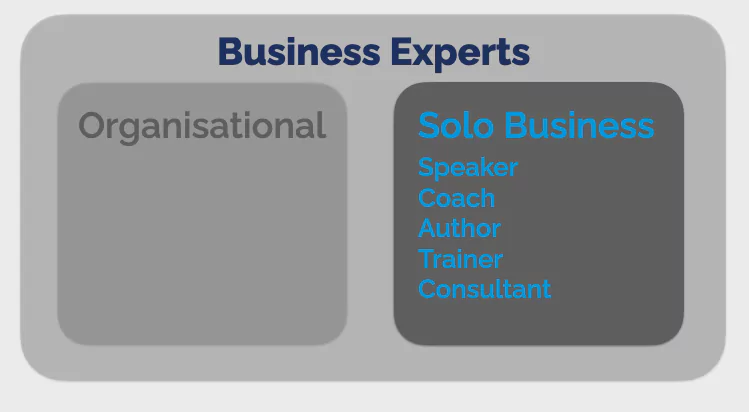
If you’re already in business, this might be easy for you: who are your existing clients? You might also like to consider: who are your ideal clients?
For me, I work with business experts. And there are two main groups of business experts – those who work in organisations and those that work outside of them. For me, this means solo business owners. These include speakers, authors, coaches, trainers and consultants.
That was easy, wasn’t it?
Note: In Scrum, they talk about the difference between the end-user and the client. They may not be the same person. For instance, a professional speaker may be paid by the conference organiser or a speaker’s bureau. But, their end-user is the audience they speak in front of.
The Big Challenge around Choosing Who to Work With
The big challenge here is to define the right size of the niche or target audience we work with.
Most people – including me – tend to err on the side of a niche that is too big. This has been a constant wrestle for me.
Most people avoid a narrow niche because of FOMO – the fear of missing out on clients. They say, ‘if I only focus on speakers, then I’ll miss the coaches that want to work with me.’
For me, I’ve resisted going to niche because I fear that my work would become too repetitive working with the same people all the time.
How Choosing a Niche that is Too Big makes Your Content Generic
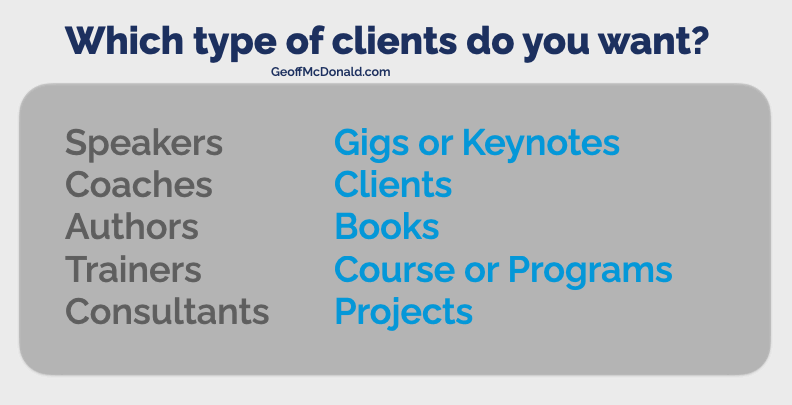
Now everyone in business wants new clients, but the words we use to describe what we want is different.
For instance, the five types of business experts I work with all describe their ideal clients differently:
- When a speaker wants a new client, they talk about speaking gigs or keynotes
- A coach talks about clients
- For authors, everything is about books.
- Trainers deliver courses or programs
- And consultants think in terms of projects.
Can you see the problem here?
When you talk to a niche that is too big, all of your messages sound generic. And this means your potential clients might not hear you.
In contrast, if you defined your niche more tightly then the words you use would be more likely to catch their attention. And that’s the first thing we need to achieve with our content – to capture attention. This all starts with speaking the right language of your potential clients.
Action: write down the jargon and industry-specific words that your clients use. Add them to your content marketing.
2 What do they Want?
The second step toward being of service is to identify what your clients want.
Most people have a shopping list of things they want. For instance:
- More money
- Better projects
- They want faster results
- Cheaper supplies
- Overcome hurdles
- To stop wasting time
- More fun at work
I’m sure you can probably add to this list with other things…
Finding the Most Important Thing Your Clients Want
Your challenge is to narrow down your shopping list to the single most important thing. And there is only one way to do this right.
Remember, this is not about you and what you want. It’s about what your clients want.
The only way to find this out is to talk with them – to ask them questions and listen to their answers.
Don’t be selfish.
If you are trying to work this out on your own, then you are doing it wrong. If you keep doing it wrong, you will keep wasting time creating great content that no one cares about.
General, Specific and Exclusive
For me, the general thing my clients want is to attract new clients.
Like I said before about the size of your niche, if I only lead with general content around wanting new clients, then it’s highly likely I would miss the deeper more specific thing they want.
The specific thing my clients want is to package up their expertise and their experience into valuable content.
And how they do this generally fits into three baskets:
- IP creation that they deliver solely to their clients.
- Content marketing to attract new clients.
- A mix of both.
Can you see how the deeper thing they want is very different from the general one?
The Great Niche Test
One test you can apply here is to ask: Is what they want exclusive to them? Wanting new clients applies to all businesses, creating valuable content applies to fewer businesses and IP creation is even more specific.
Can you see how digging deeper about what they want also defines who our clients are at a deeper level?
3 Why our clients want what they want
The third step towards being of service is to identify why your clients want what they want it.
In other words, what’s their motivation?
For my clients, the reason they want to create valuable content is that they want to earn money from what they know. If they just wanted more clients, then they could advertise or have more meetings.
But their driving force is that they want to tap into the three Es of years of education, experience and expertise.
And this points to three levels of client motivation that you need to consider.
The Three Levels of Client Motivation
Everyone wants more money. This is a practical, tangible and visible thing we all want.
But why do we want that?
Neuroscience suggests that we always make decisions based on our emotions and then we rationalise them with words and things. We say we want money but what’s really driving us is the emotions we feel from getting that money. This might be peace of mind so they can look after their family, it might be competition to say they were paid some ridiculous amount to do a presentation, or it might be altruistic – now I can help others.
The Boat and Your Clients’ Motivation
Money is like a boat on the surface of the water – it’s the tangible thing that money can buy.
But just below the surface is our emotional reasons for buying something.
But wait, there’s more – there’s a deeper evolutionary reason for buying than pure emotions.
In the days of the caveman, if you were alone then you had a much higher risk of dying. But if you stayed together as a tribe, then your chances of surviving grew significantly.
We’re hardwired to be social creatures. (This is why being selfish – thinking about your needs ahead of everyone else is frowned upon.) And if we truly want to create content that connects with our intended audience then we need to include the deeper social reasons as to why we want something.
The question to ask here is: How do your clients want to be seen by others?
While we might talk about how we feel, we almost never talk about our social concerns. That’s why it can be a deeper force than emotions.
(One example of this is selfish content – none of us wants to admit in public that’s what we’ve been doing – blatantly or not.)
Social Motivations
If you can tap into the social motivations of your clients, then you can connect at a much deeper level with your content.
For me, my clients want to lead with their ideas. This is a social role and the direct result of their content creation.
But here’s the important piece. If I asked them if they wanted this, most of them would say ‘no it’s not about that’.
Even though this is a deeper motivation, it’s not a good one to lead within my headlines. But if I include it and share it along the way, it will add depth and meaning to my message.
Note: When you’re talking with your clients about their social motivations, don’t expect them to give you a good answer to the direct question: How do you want to be seen by others? Some people may answer, some may choose not to and others may not know what’s driving their social motivations. The key is to listen to what’s not being said.
In some situations, looking at the physical and environmental clues of your clients can help:
- Are they well dressed and well-groomed?
- Do they drive a flash car?
- What photos do they have on their wall?
Your Client Value Proposition Statement – Putting it all together
Well done, if you’ve been working through this, you’ll now have a three-part statement of
- Who is my client?
- What do they want?
- Why do they want it?
Now for the exciting part of putting it all together into a single statement. There is no magic required here, some state your answers to the three questions as one sentence.
For me, my statement is: I work with business experts to create high-quality content to earn money from what they know.
What does your client value statement or value proposition say? Add a comment below to share.
Summary: Your Content Creation Value Proposition
One of the big reasons that a lot of content creators don’t attract new clients is because their content is selfish.
It speaks more about yourself than what your clients want.
This can be blatant or accidental as the Expert’s Curse.
If that fits for you, it’s time to stop being selfish.
If you do want to shift your results and start getting emails from potential clients and build an audience around your content creation, then create your value proposition statement using the three questions:
- Who is your client?
- What do they want?
- Why do they want it?
As Zig Ziglar once said, “if you help enough people get what they want, then you’ll get what you want”.
In our next post in this series, we’ll apply what we’ve done today into creating thought leadership quality content.
More: Dig deeper with these resources
If you want more on creating your value proposition or client value statement, or perhaps on the Content Creation Canvas, here are some links to consider:
- Overview: Content Creation Canvas: Build thought leadership, attract new clients
- Part 1 in this series: Content Strategy 2022 – Best framework for Thought Leaders
- Previously on this topic: Know Your Clients Thoughts
Leave a Comment
What does your client value proposition say? I’m happy to add some feedback if you’d like some.

